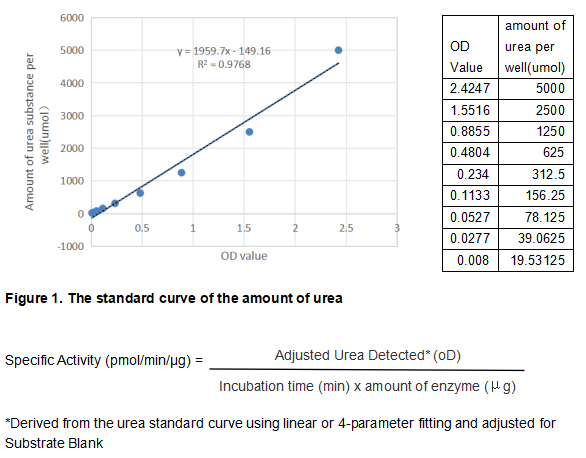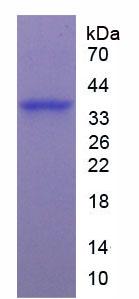Active Arginase (ARG) 

ARG1; Arginase I; Liver Arginase
- UOM
- FOB US$ 301.00 US$ 752.00 US$ 1,504.00 US$ 4,512.00 US$ 11,280.00
- Quantity
Overview
Properties
- Product No.APB120Hu01
- Organism SpeciesHomo sapiens (Human) Same name, Different species.
- ApplicationsCell culture; Activity Assays.
Research use only - DownloadInstruction Manual
- CategoryEnzyme & KinaseTumor immunityInfection immunityHepatology
- Buffer Formulation20mM Tris, 150mM NaCl, pH8.0, containing 1mM EDTA, 1mM DTT, 0.01% SKL, 5% Trehalose and Proclin300.
- Traits Freeze-dried powder, Purity > 97%
- Isoelectric Point6.7
Sign into your account
Share a new citation as an author
Upload your experimental result
Review

Contact us
Please fill in the blank.
Activity test

Arginase (ARG) is a kind of inducible manganese (Mn2 )-containing enzymes that catalyse the final step of the urea cycle in the liver, converting l -arginine into l -ornithine and urea.Therefore, we can measure its bioactivity by enzyme activity assay. Recombinant human Arg was diluted to different concentrations in deionized water.Loading 40 µL of the rhARG1 and 10ul Substrate mixture(100 mM Arginine, 500 mM Glycine, 1.25 mM MnCl2, pH 10.5 ) into the plate. Incubated at 37 °C for 2 hours and stop the reaction with 200 µL stop solution of the 2 mM oPA, 2 mM NED ,50 mM Boric Acid, 1 M Sulfuric Acid, 0.03% Brij-35 (w/v) .Cover the plate and incubate at room temperature for 20 minutes and read at 520 nm (absorbance) in endpoint mode. The specific activity of recombinant human ARG is >24400pmol/min/ug.
Usage
Reconstitute in 20mM Tris, 150mM NaCl (pH8.0) to a concentration of 0.1-1.0 mg/mL. Do not vortex.
Storage
Avoid repeated freeze/thaw cycles. Store at 2-8°C for one month. Aliquot and store at -80°C for 12 months.
Stability
The thermal stability is described by the loss rate. The loss rate was determined by accelerated thermal degradation test, that is, incubate the protein at 37°C for 48h, and no obvious degradation and precipitation were observed. The loss rate is less than 5% within the expiration date under appropriate storage condition.
Increment services
-
 BCA Protein Quantification Kit
BCA Protein Quantification Kit
-
 Molecular Mass Marker for Protein
Molecular Mass Marker for Protein
-
 Monoclonal Antibody Customized Service
Monoclonal Antibody Customized Service
-
 Polyclonal Antibody Customized Service
Polyclonal Antibody Customized Service
-
 Protein Activity Test Experiment Service
Protein Activity Test Experiment Service
-
 Electrophoretic Mobility Shift Assay (EMSA) Experiment Service
Electrophoretic Mobility Shift Assay (EMSA) Experiment Service
-
 Buffer
Buffer
-
 Lentivirus Packaging Experiment Service
Lentivirus Packaging Experiment Service
-
 Adenovirus Packaging Experiment Service
Adenovirus Packaging Experiment Service
-
 Real Time PCR Experimental Service
Real Time PCR Experimental Service
-
 Spike RBD Protein (S-RBD)
Spike RBD Protein (S-RBD)
-
 Protein G
Protein G
-
 Protein A
Protein A
Citations
- Phenobarbital Induces Alterations in the Proteome of Hepatocytes and Mesenchymal Cells of Rat LiversPubmed: 24204595
- Arginase I release from activated neutrophils induces peripheral immunosuppression in a murine model of strokePubMed: 25966956
- Circulating CD14+HLA-DR-/low myeloid-derived suppressor cells in leukemia patients with allogeneic hematopoietic stem cell transplantation: novel clinical potential strategies for the prevention and cellular therapy of graft-versus-host diseasePubmed:27109254
- Toxoplasma gondii GRA15II effector-induced M1 cells ameliorate liver fibrosis in mice infected with Schistosomiasis japonicaPubmed:27157496
- Potent but transient immunosuppression of T-cells is a general feature of erythroid progenitor cells
- Potent but transient immunosuppression of T-cells is a general feature of CD71+ erythroid cells34893694









